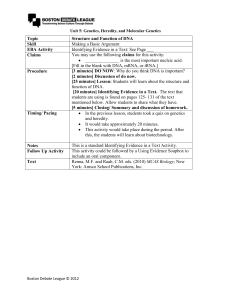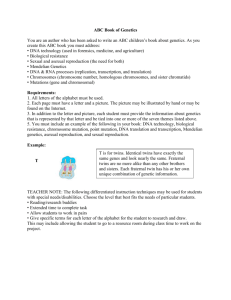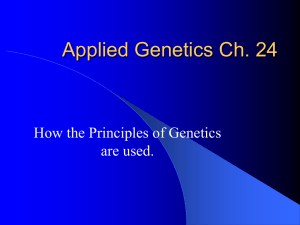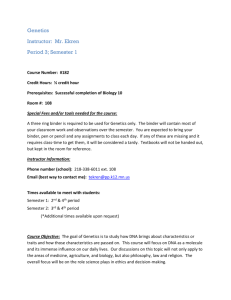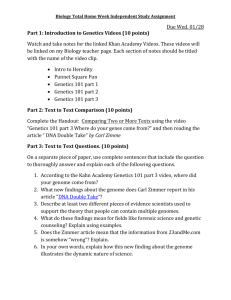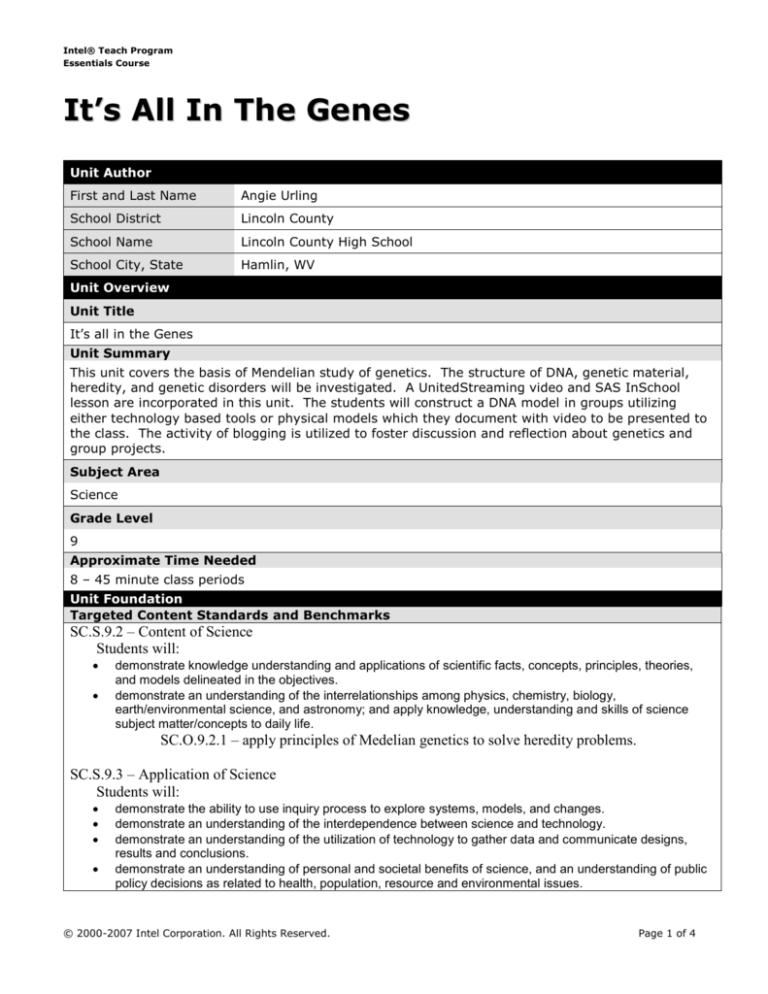
Intel® Teach Program
Essentials Course
It’s All In The Genes
Unit Author
First and Last Name
Angie Urling
School District
Lincoln County
School Name
Lincoln County High School
School City, State
Hamlin, WV
Unit Overview
Unit Title
It’s all in the Genes
Unit Summary
This unit covers the basis of Mendelian study of genetics. The structure of DNA, genetic material,
heredity, and genetic disorders will be investigated. A UnitedStreaming video and SAS InSchool
lesson are incorporated in this unit. The students will construct a DNA model in groups utilizing
either technology based tools or physical models which they document with video to be presented to
the class. The activity of blogging is utilized to foster discussion and reflection about genetics and
group projects.
Subject Area
Science
Grade Level
9
Approximate Time Needed
8 – 45 minute class periods
Unit Foundation
Targeted Content Standards and Benchmarks
SC.S.9.2 – Content of Science
Students will:
demonstrate knowledge understanding and applications of scientific facts, concepts, principles, theories,
and models delineated in the objectives.
demonstrate an understanding of the interrelationships among physics, chemistry, biology,
earth/environmental science, and astronomy; and apply knowledge, understanding and skills of science
subject matter/concepts to daily life.
SC.O.9.2.1 – apply principles of Medelian genetics to solve heredity problems.
SC.S.9.3 – Application of Science
Students will:
demonstrate the ability to use inquiry process to explore systems, models, and changes.
demonstrate an understanding of the interdependence between science and technology.
demonstrate an understanding of the utilization of technology to gather data and communicate designs,
results and conclusions.
demonstrate an understanding of personal and societal benefits of science, and an understanding of public
policy decisions as related to health, population, resource and environmental issues.
© 2000-2007 Intel Corporation. All Rights Reserved.
Page 1 of 4
Intel® Teach Program
Essentials Course
SC.O.9.3.6 – given a current science-technology-societal issue, construct and defend
potential solutions.
Student Objectives/Learning Outcomes
Students will demonstrate knowledge understanding and applications of genetics to solve heredity
problems, demonstrate the ability to explore genetic codes, demonstrate an understanding of the
interdependence between science and technology, demonstrate an understanding of the use of
technology to analyze DNA structures and genetic material, demonstrate an understanding of the
societal benefits to genetic research.
Curriculum-Framing Questions
Essential
What are you made of?
Question
Unit
Questions
What is genetic code?
What is the social responsibility of acquiring scientific knowledge?
What is the impact of biological discoveries and technological advances on
society and on other living organisms?
Content
Questions
What impact does the study of heredity and genetics have on society?
What can we learn from DNA?
Is cloning an appropriate use of genetic knowledge?
How do CSI detectives use DNA to solve crimes?
Assessment Plan
Assessment Timeline
Before project work begins
KWL
Blog
Survey
Blog checklist
Students work on projects
and complete tasks
Student lab
data sheet
Student data
analysis
Blog
Genetics Wiki
Student
Checklist
Student DNA
model
After project work is
completed
Peer
evaluation of
group work
Self evaluation
of individual
project
SAS In
Teacher
School report
evaluation of
final group
project –
project rubric
Assessment Summary
K-W-L Chart
Students develop classroom and individual Know-Wonder-Learn charts about genetics. Students use
these to access prior understanding, brainstorm ideas, think about questions to research, and reflect on
© 2000-2007 Intel Corporation. All Rights Reserved.
Page 2 of 4
Intel® Teach Program
Essentials Course
their learning. Use the K-W-L initially to gauge readiness and interests and then during the unit to promote
metacognition of learning progress as students revisit them and reflect.
Survey
At the beginning of this unit, a survey will be completed by students based on their prior knowledge about
genetics.
Blog
Students post to blogs throughout the unit to explore their thoughts and provide feedback to each other on
a variety of subjects. The information from these blog entries is used to provide individual and group
feedback as students work on their projects.
Blog Checklist
Students will use a checklist to evaluate their blog posting.
Lab Data Sheet As students manipulate the online interactive SAS InSchool lab for genetics, they will record data in their
lab data sheet for future analysis and collaboration with their fellow students.
Data Analysis
Students will use a Punnett square to interpret the results of monohybrid and dihybrid genetic crosses.
They will also identify the genotypes of one or more unknown individuals based on their phenotypes and
the phenotypes of their offspring. Students will also use Mendle’s principles of segregation and
independent assortment to explain the outcomes of a series of genetic crosses.
Wiki Checklist
After discussing the beginning stages of genetics and assessing prior student knowledge,
students will access the following wiki and blog about one of the posted questions. The
students will post their answer then read and respond to at least two others postings by
other students.
DNA Model
The DNA model the students construct will be assessed based on a rubric for the composition of the
model. Protein pairs, double-helix structure, and replication must be included in the model.
Peer Evaluation Peer evaluation of the presentation will be conducted with checklists based on group collaboration and
sharing of information.
Self Evaluation
Students will evaluate themselves based on their group work, project work, and understanding of the unit
of genetics. The teacher will conference with students based on their evaluation responses.
Final
Presentation
Each group will provide a final presentation of their model and group video documentation. Students will
create a video podcast that will be embedded in the wiki for final viewing by the class.
Unit Details
Prerequisite Skills
Students must have a prior basis of understanding the process of cell division and cell reproduction
processes.
Instructional Procedures
Students will interact with the SAS InSchool genetics interactive lab (Interactivity 869). They will
Accommodations for Differentiated Instruction
Resource
Student
Accommodations for resource students include graphic organizers, assignment
calendars, grouping, adaptive technologies, recordings of instructions for future
reference, support from specialists.
Nonnative
English
Speaker
This does not apply to my student base.
Gifted
Student
Accommodations for gifted students include challenging questions and tasks,
extensions that require further investigation, and peer coaching opportunities.
Materials and Resources Required For Unit
© 2000-2007 Intel Corporation. All Rights Reserved.
Page 3 of 4
Intel® Teach Program
Essentials Course
Technology – Hardware (Click boxes of all equipment needed)
Camera
Laser Disk
VCR
Computer(s)
Printer
Video Camera
Digital Camera
Projection System
Video Conferencing Equip.
DVD Player
Scanner
Other SMART Board
Internet Connection
Television
Technology – Software (Click boxes of all software needed.)
Database/Spreadsheet
Image Processing
Web Page Development
Desktop Publishing
Internet Web Browser
Word Processing
E-mail Software
Multimedia
Other Wiki allowed through filter.
Encyclopedia on CD-ROM
Printed Materials
Supplies
SAS InSchool Data sheet, student checklist, student login information, and
instructions for wiki.
Student model materials for DNA model needed on hand. Examples: plastic
DNA model components, pipe cleaners, sting, different colored beads, ring
stands, tape, wire, glue, Styrofoam.
www.sasinschool.com
www.unitedstreaming.com
Internet Resources
http://urlgenetics.pbwiki.com/
http://aurling.googlepages.com/genetics
Survey (hosted on SurveyMonkey website.)
Other Resources
Electrophoresis for genetic analysis based on one sample per class.
Programs of the Intel® Education Initiative are funded by the Intel Foundation and Intel Corporation.
Copyright © 2007, Intel Corporation. All rights reserved. Intel, the Intel logo, Intel Education Initiative, and Intel Teach Program are
trademarks of Intel Corporation in the U.S. and other countries. *Other names and brands may be claimed as the property of others.
© 2000-2007 Intel Corporation. All Rights Reserved.
Page 4 of 4


